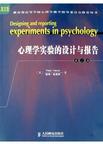心理学实验的设计与报告
出版时间:2004-11 出版社:人民邮电出版社 作者:彼得・哈里斯 页数:214
Tag标签:无
内容概要
心理学实验在心理学科的发展进程中具有不可替代的作用。而心理学研究报告(或论文)是心理学研究成果最重要的表达形式之一。心理学研究报告的撰写既涉及与研究课题的理论背景、研究假设等相关的科学知识,又涉及与实验设计、统计相关的实验结构知识和与心理学科技论文写作规范相关的知识。这种论文撰写能力的形成和提升尚需要一个不断训练、不断实践的过程。就我国高等院校的心理学专业目前所开设的诸如:普通心理学、认知心理学、实验心理学、心理统计等专业基础课程而言,似无法独立完成对学生的这种综合训练,因此有必要开设相应的课程或专题。 《心理学实验的设计与报告》语言简练、易读易懂,对学生在撰写研究报告过程中所遇到的实际问题给出了操作性很强的指导,可作为我国高等院校心理学专业学生(包括本科生和研究生)的教材或教学参考书,也可作为心理学工作者撰写心理学研究报告(或论文)的参考手册。
作者简介
彼得·哈里斯是英国谢菲尔德大学心理系的讲师,他曾在萨塞克斯大学、赫特福德大学和诺丁汉大学工作过,也曾在阿姆斯特丹大学和牛津大学做过访问学者。他主要的研究方向是社会和健康心理学。
书籍目录
PrefaceTo studentsHow to use this bookTo tutorsPart 1 Writing experimental reports1 Some preliminaries1.1 Experienced students, inexperienced students and the report1.2 Writing the repor1.3 The importance of referencing in the text1.4 The report as a research instrument1.5 Finding things to write about: how to get more references1.6 Experimental ethics2 The INTRODUCTION section2.1 The first part of the INTRODUCTION: reviewing the background to your study2.2 Inexperienced students, experienced students and the INTRODUCTION2.3 Your own study3 The METHODcsection3.1 The DESIGN subsection3.2 The PARTICIPANTS subsection3.3 The APPARATUS or MATERIALS subsection3.4 The PROCEDURE subsection3.5 Interacting with and instructing participants3.6 Optional additional subsections of the METHOD4 The RESULTS section4.1 Describing the data4.2 Analysing the data4.3 An example RESULTS section4.4 Mistakes to avoid in the RESULTS section4.5 Rejecting or not rejecting the null hypothesis4.6 Reporting specific statistics5 The DISCUSSION section5.1 How well do the findings fit the predictions?5.2 What do the findings mean?5.3 What are the implications of these findings? 5.4 What to do when you've been unable to analyse your data properly55.5 External validity:the generalizability of findings5.6 Some tips to help you to avoid some common failings in the DISCUSSION5.7 Two example DISCUSSION sections6 The TITLE and ABSTRACT6.1 The TITLE6.2 The ABSTRACT7 References and appendices7.1 The REFERENCES section7.2 General rules for the REFERENCES section7.3 Citing specific types of reference7.4 Citing electronic and online sources7.5 Appendices8 Producing the final version of the reportPart 2 Designing experiments9 Experimenting in psychology10 Experimental design I11 Statistics:significance testing12 Statistics:effect size and power13 Experimental design IICommentaryRecommended readingAnswers to SAQsReferences
图书封面
图书标签Tags
无
评论、评分、阅读与下载
用户评论 (总计17条)
- 心理学必备
- 对心理学的学习很有帮助
- 感觉语言平实,英文版,但能读懂,对英语水平要求不是太高。
- 发布高质量外文文字的参考书。内容充实,详尽
- 还没来得及看 期待。。
- 阅读有一定英语要求
- 现在才看完。书不是很厚,但作为心理学专业本科的研究入门书籍算是很不错的了。建议想学好专业的特别是想今后从事研究童鞋好好看看。。
- 用來當大學的參考書,這本書的英文版在香港喜的頗貴而且內容和香港的一樣
- 准备学习!物流超级快~
- 嗯,如题。
- 替同學買的書,由於是全英文的,所以覺得這個一方面對自己的英語水平是一個挑戰,另一方面也可以學習到原版書籍的內涵。
- 还不错,只是作者是英国的,感觉跟美式英语还是有点不同
- 版本看起来好旧!!
- 书很漂亮。里面的内容很全面。适合初学者使用
- 有时间的话还是看看原版的比较好~~
- 适合正在读本科生的同学们,可以有一些提高。研究生看上去就稍微有些浅了。很多可以操作的指导性列表。:)
- 适合心理学本科生和初学者使用,内容很全面,原版很好,但译文很一般,所以不是专业人士就不要买了。
